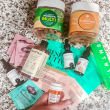I don’t know how to introduce this delicately so I’m just going to say it: My name is Dena, and I have Stage IV Metastatic Breast Cancer. Shhhhhh, put your pity away. Save it for people who need it—like the woman I saw wearing a mini skirt in Chicago this week. (It’s colder than Mars here!) My heart bleeds for her.
So yes, I have this incredibly scary disease. Stage IV Mets cancer currently has a 100% mortality rate, but that doesn’t mean I am going to die tomorrow. People live for decades with more severe cases than mine. I have a kind of breast cancer called “triple positive,” which means that my cancer basically eats hormones to grow. That also mean I can control it in a lot of interesting and scientific ways by manipulating my estrogen, HER2NEU, and progesterone levels. These hormones, as you will be familiar, are also related to puberty, periods, being a woman, stress… All of which is to say that for me, cancer means I break out a lot.
And while my cancer may be unique to just me, the acne it causes is just like everyone else’s acne. Except, instead of just once a month around my period, I get it all the time. Four years after my initial cancer diagnosis, I still get chemotherapy every three weeks. It’s a targeted biological treatment, delivering poison to mostly just the cells that have HER2 receptors. I also get a lupron shot every three months that shuts down my ovaries so I don’t produce estrogen. Anything that attacks my cancer cells is going to mess up healthy cells in the process, which is a nice way of saying that my treatment seriously effs with my skin in more ways than one.
By far the most frustrating of all is the cystic acne. You know, those deep, usually painful bumps that are lodged below several layers of skin and are sore to the touch? They are caused by anything that lowers estrogen levels, including my therapies and the time leading up to menstruation. Zits like this aren’t just about the bacterial infection, but also the inflammatory healing response. Swelling and pus (those valiant dead white blood cell soldiers) are how our bodies like to battle infection. But it doesn't look that good. Here's how I've learned to deal:
THE TREATMENTS
When it comes to my gigantic hormonal zits, the infection is happening deep below the surface, so that is where the cure needs to be also. The gold standard for this is a cortisone shot.
Cortisone is a powerful anti-inflammatory and, when injected, will shrink a cyst in anywhere from a few hours to three days. Downsides include pain during the injection, cost, and the fact that the zit has to get pretty big for any reputable doctor to treat it this way. And it doesn’t always work, depending on the nature of the infection. You can also get permanent ice pick scars from over-injecting, or injecting spots that are too superficial.
What's better is treating the brewing infections before they have much to show for themseles. I've found lactic acid is particularly good at this, and nothing has worked for me like the Renée Rouleau Anti-Cyst Treatment, which boasts an especially effective form of the molecule.
I’ve also had success with devices—namely high-frequency machines and IPL laser treatments. Both work by using light to kill bacteria under the skin, and introducing heat and oxygen below the surface to boost circulation to clear things out. Treatment can cut down the two-to-three week lifespan of these cysts to about a week, but that’s still kind of disappointing. Which leads me to…
THE PREVENTION
Painful, persistent acne drove me to the great dermatologist quest of 2016. Which thankfully led me to Dr. Pinski in Chicago. He is the sweetest, and also exceptional at explaining things that will help you understand your treatment plan. He believes in prevention above all else, and his methodology is focused on getting back in balance. While I would rather have a maximalist approach, Dr. P’s got me locked into a pretty tight routine to achieve that elusive balance that my skin needs to be acne-free.
On his recommendation, I wake up and wash my face with Dermamedics Foaming Cleanser, a light glycolic acid-based foam gentle enough to be used twice a day. It is kind of pricey and I can only buy it from him, but after two days of using it, the difference on my chin was so impressive and noticeable. It’s probably the fastest working product on this list.
After the cleanser, I tone with Biologique Recherche P50. I just can’t quit it. The lotion pairs blockage-clearing lactic acid in a dilution of vinegar, which balances the pH. Fun fact I learned when I got to visit the lab where they invented my chemo: Cellular inflammation thrives in basic environments, so lowering my pH can help prevent breakouts. Raising my body’s pH can help inflammation grow faster, as I learned watching them grow breast cancer cells in a petri dish.
If my face has been real bad, I will make time to sit with an incredibly awkward and slightly claustrophobic LED light mask on. At this point, my husband is used to looking over and seeing me with weird shit on my face. I'll do 20 minutes at full power in both red and blue, since different colored lights treat inflammation (red) and infection (blue). Afterwards, I apply Glossier Super Pure to bottom half of my face, followed by a rose damask or aloe gel on top of it in a thick layer before running my Nuface or my Jenu over the area because microcurrent increases absorption. I finish with a special neogenic moisturizer my doctor compounded for me. Then I mist my whole face with rosewater, because I freaking love the smell of it and it makes me happy.
In the middle of the day when I workout, I'll do a quick wash or wipe with whatever is handy. My steadfast rule is I must de-sweat my face within five minutes of finishing a workout because bacteria loves sweat almost as much as it loves sebum. Then I do a few drops of any vitaminc C serum and a moisturizer with sunscreen. My friend who’s a cosmetic chemist told me C can increase the effectiveness of sunscreen, and sun is my sworn enemy.
At night I do a double cleanse—first with Glossier Milky Jelly to get my makeup off, then the glycolic foaming cleanser. I have to wait five minutes after for everything to calm down before I can apply my Aczone prescription. Then I top the whole thing off with the neogenic moisturizer.
My dermatologist strongly recommends an oil-free foundation, and since everything else he told me has worked so well I have had to abandon my beloved Armani for Bobbi Brown. I love how it goes on, but I feel like it gives just a little too much coverage for everyday so I only use it for special occasions. Instead, I started using anti-acne concealers and just spot treat. Depending on the texture I want I will either use CoverFx Blemish Treatment Concealer, which is creamier and more blendable, or BareMinerals Blemish Remedy Concealer, which is matte and sticky and smells heavily of tea tree oil. On my cheeks and nose I use NIOD Photography Fluid, which is this thick white cream that looks like it should be scary, but goes on as this blurring, light-reflecting, glowing veil that makes little pores disappear and everything just look healthy.
If you have acne that persists after all of this, like I did for months, sometimes you just have to bring out the big guns. Trust me, I am so sick and wary of any additional medicine, but if you’re spending a small fortune and two hours a day on acne products and still suffering, then you suck it up and take a pill. I am about six weeks on Spironolactone, AKA the best kept secret in the beauty world. It works by controlling the production of progesterone, testosterone, and aldosterone, also making it a diuretic as well since this last hormone acts in the kidneys, where it regulates the balance of salt and water in the body.
The most fun for me is my weekly “spa day.” I would mask for hours if it wouldn’t completely destroy my skin. Right now I have a borderline obsession with the Caudalie Glycolic Peel. Don’t ask me why I decided I needed more glycolic, the truth is I read about it on an #ITGTopShelfie before I realized my cleanser was glycolic-based, and the results have got me hooked. I have to follow it up with a soothing sheet mask, and I have had unbelievable results with the Peach and Lily Reset Button. After I do this combo, I feel like my skin is less red and inflamed, the healing spots are less pigmented, and everything is glowing.
Lastly, I’ve decided that having one pimple is actually cute. It’s a sign of fertility, of youth, of fecundity. Sometimes when you can’t change the circumstances, the only thing you have control over is how you feel about them. I choose to be happy.
—Dena Smith
Dena Smith is beauty writer who has been featured in Cosmopolitan.com, Self.com, People.com, Refinery 29, Lenny, and more. Her blog, Leo With Cancer, is a pun that no one gets.
Photos via the author.















